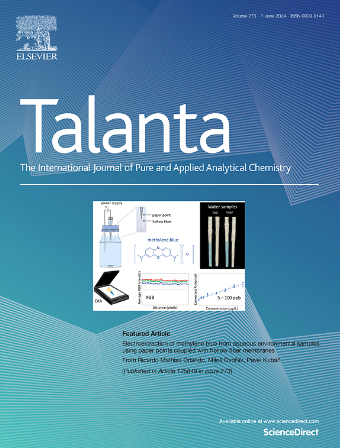A ratio luminescent europium organometallic gel for in vitro detection of hepatocellular carcinoma marker and cellular imaging
IF 5.6
1区 化学
Q1 CHEMISTRY, ANALYTICAL
引用次数: 0
Abstract
Hepatocellular carcinoma is a particularly aggressive form of liver malignancy, representing one of the most formidable threats to human health and a major contributor to cancer-related deaths. Cholyglycine (CG), which plays a pivotal role in lipid metabolism, has garnered attention as a potential biomarker for hepatocellular carcinoma. Nevertheless, the structural resemblance of CG to various bile acids complicates the specific identification of CG. Therefore, the effective monitoring of CG in biological samples is still a challenge to be solved. In this study, a europium-based metal organic gel (Eu-MOG) with dual emission was synthesized and displayed an obvious luminescent color change from red to blue for CG. The synthesized Eu-MOG exhibits excellent selectivity towards CG, and enables the sensitive detection of CG in serum with LOD as 307 ppb. This character of Eu-MOG has also been validated in cell imaging for CG, which make this europium-based probe sufficient for clinical monitoring of CG to diagnosis hepatocellular carcinoma. The results of our experiments, corroborated by theoretical calculations, indicate that the high sensitivity of MOG to CG stems from the intermolecular N–H⋯O interaction between CG and the ligand H2NDC. This interaction facilitates intermolecular charge transfer, which in turn alters the luminescence of the europium-based metal-organic gel (Eu-MOG). This study provides a robust platform for the early diagnosis of hepatocellular carcinoma and contributes significantly to the evaluation of human hepatobiliary metabolic status.

求助全文
约1分钟内获得全文
求助全文
来源期刊

Talanta
化学-分析化学
CiteScore
12.30
自引率
4.90%
发文量
861
审稿时长
29 days
期刊介绍:
Talanta provides a forum for the publication of original research papers, short communications, and critical reviews in all branches of pure and applied analytical chemistry. Papers are evaluated based on established guidelines, including the fundamental nature of the study, scientific novelty, substantial improvement or advantage over existing technology or methods, and demonstrated analytical applicability. Original research papers on fundamental studies, and on novel sensor and instrumentation developments, are encouraged. Novel or improved applications in areas such as clinical and biological chemistry, environmental analysis, geochemistry, materials science and engineering, and analytical platforms for omics development are welcome.
Analytical performance of methods should be determined, including interference and matrix effects, and methods should be validated by comparison with a standard method, or analysis of a certified reference material. Simple spiking recoveries may not be sufficient. The developed method should especially comprise information on selectivity, sensitivity, detection limits, accuracy, and reliability. However, applying official validation or robustness studies to a routine method or technique does not necessarily constitute novelty. Proper statistical treatment of the data should be provided. Relevant literature should be cited, including related publications by the authors, and authors should discuss how their proposed methodology compares with previously reported methods.
 求助内容:
求助内容: 应助结果提醒方式:
应助结果提醒方式:


